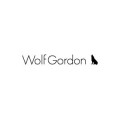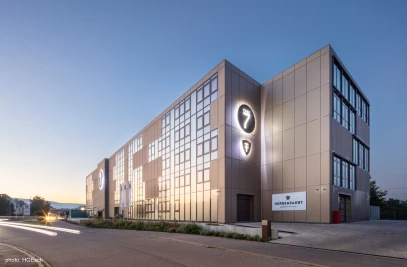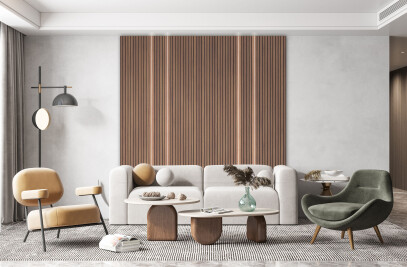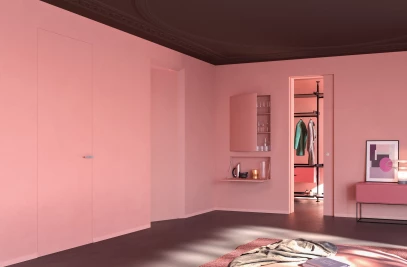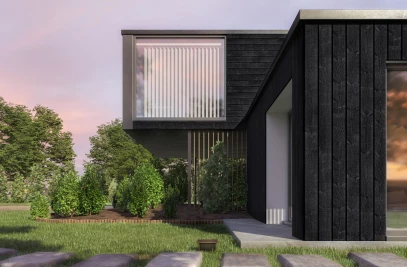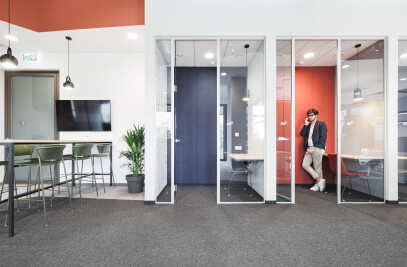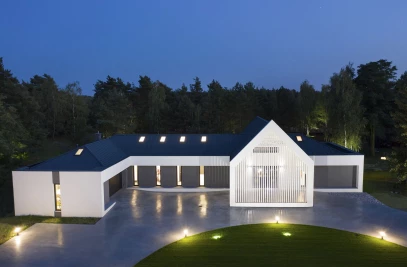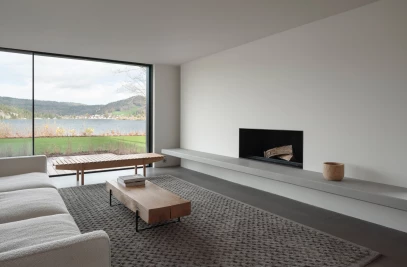When wandering the aisles of a large trade show such as HD Expo in Las Vegas, one does not expect to encounter a provocative exhibition on artificial intelligence. However, that is precisely what Wolf-Gordon presented May 2–4, 2023, at the Mandalay Bay Convention Center. In the guise of a booth showcasing the company’s digitally printed wallcoverings on PVC-free substrates, “Project: HI > AI” went deep: seven distinguished artists created original patterns that explored such diverse themes as the process of making, the uniqueness of human-generated art, and anxiety over impinging technology, surveillance, and control in our lives.
With the artists’ original works in hand, Wolf-Gordon Design Studio (WGDS) extracted verbal prompts from the patterns that were input into AI imaging software with the aim of creating outputs that were as close as possible to the originals. Although the AI software could not match the humans’ creations, the results were remarkable for their range of interpretation and, in some instances, outputs that delighted for their otherworldly takes on organic and traditional motifs, hand-drawn and -painted compositions, and multi-step art making processes.
To ensure a varied and lively set of works, curator Marybeth Shaw, chief creative officer at Wolf-Gordon, invited artists working in several different media, from conceptual art and printmaking to art jewelry, calligraphy, textiles, and interior design. Shaw launched the project with a song, Human Behavior, by Bjork (1993), written from the perspective of an animal observing humans. She suggested that for “Project: HI > AI,” we might replace the animal with a machine. How would AI interpret a 48" x 48" pattern designed by a human?
Based on the results exhibited in Las Vegas, the artists delighted in devising different ways to fool the AI and made replicating their patterns as difficult as possible. Christine Tarkowski, artist and professor at the School of the Art Institute of Chicago, generated her pattern, Large Square, by folding water-soaked butcher paper over and over into a square and then drizzling 2000º F molten glass onto the folded paper. The glass burned through several layers, revealing a pattern when extinguished and unfolded. While Tarkowski’s juxtaposition of geometry to entropic action—a persistent theme in her work—was impossible for the AI to match precisely, through several different sets of verbal prompts, the image of folded paper aflame in the AI version is relatable.
Calligrapher and sign painter Jen Mussari explored the foundational shapes of her art in Pattern 2. She writes, “My pattern is made of simple typographic building blocks. Trained human hands have made words for communication from these shapes for centuries, but what would a machine do with something seemingly so simple?” When WGDS input Mussari’s prompt—‘a linear pattern of calligraphy brushstrokes reminiscent of the building blocks of hand-drawn typographic forms’—the supergraphic output from the AI software was so compelling that they kept it as a large non-repeating mural.
The work undertaken with Midjourney and DALL-E by WGDS quickly revealed the importance of language in “Project: HI > AI.” In most cases, design director Michael Loughlin had to manipulate the artists’ original prompts to get outputs that approximated the art. In other instances, the end goal shifted to enable the AI to express a strange new variation on the original art that the Studio found compelling. Because no AI is currently able to replicate the original art closely enough, WGDS acknowledges the essential presence of the human software operator to influence outcomes.
In several cases, the language needed to be rendered simpler and more straightforward. For designer Frank Tjepkema’s exquisite floral, Famossa, which he created on CAD software, a lengthy list of words yielded a better result when edited down. “Magnetic field, organic, parametric,” as interpreted by Midjourney, output a fantastical, alien flower that one might encounter on Queen Amidala’s planet, Naboo.
In another case, that of textile artist Raylene Marasco’s hand-painted Furrows, the trick of the language was to rearrange the original prompt and add a few cues like “brick-like layout” and “soft grey color.” While less nuanced than Marasco’s painting, which she executed by dragging pigment down an unevenly hand-dyed fabric with a vintage metal graining comb, DALL-E output a complex light-infused pattern that resembles a high-tech ikat.
Native American metalsmith Pat Pruitt’s Thunder & Lightning pattern also proved too geometrically abstract for the AI software to replicate. In Pueblo art, lightning symbolizes the water serpent, Avanyu, and the importance of rainfall to desert agriculture. Pruitt’s particular pattern for lightning, also seen on his much-coveted wrist cuffs, was interpreted by DALL-E as a more cartoon-like zig zag.
Print media artist Hilary Lorenz’s Migration is the ultimate demonstration of the uniqueness of each living being and of each work of art. Lorenz has created awe-inspiring installations of individually printed and cutout hawk moths, most recently at the Denver Botanic Garden, which celebrate these winged insects as pollinators and metaphors for the exchange of ideas. Midjourney generated a pattern of the moths in flight that could be said to be a distant cousin of Lorenz’s concept, at a significantly lower degree of resolution and, notably, in a very cloned, serialized repeat.
Perhaps most directly answering the question posed in the program— “What makes human-designed work uniquely human?”—is Playful Toile by Ghislaine Vinas. In her own words, she answers, “What is so inherently, indisputably human? Taking something ‘good’ and turning it on its head. This is our tableau of human-inflicted adversities existing in a developing or, controversially, collapsing world: surveillance, technology run amok, and domestication. It’s a mash-up of misfortunes under the guise of a perfectly pleasing pattern, all penned by the very same human hand.” Midjourney output a traditional wallpaper pattern but couldn’t match the degree of threat designed by Vinas.
“Project: HI > AI” is a timely snapshot of the meeting of human intelligence and AI. Interestingly, the technology is evolving so quickly that AI patterns printed in April 2023 could already be rendered in higher resolution in May. Beyond the possibility of utilizing AI imaging software in commercial pattern design and the crucial role of language in the translation of imagery, this exhibition highlights what Shaw refers to as the cognitive rupture in viewing AI-generated art. She posits, “Visual elements in several of the patterns in the exhibition introduce something distinctively new. These inventions will undoubtedly influence human artists. Elements of AI imagery will make their way into human-generated works, thus setting up a potentially beneficial, or at least benign, symbiotic relationship between human and machine in writing, art, and design.”
“Project: HI > AI” will be on display in Wolf-Gordon’s Headquarters, 333 Seventh Avenue, New York, NY beginning May 23, 2023, and continuing through the end of December.










































